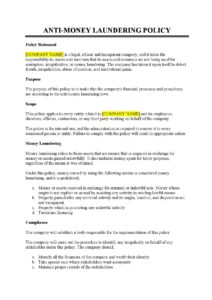Money laundering is the process of concealing the origin of illegally obtained money, typically through the use of financial transactions in order to make it appear legitimate. It can be a complex and sophisticated process, often involving multiple steps and jurisdictions.
Anti-money laundering (AML) policies and procedures are designed to help prevent money laundering and terrorist financing. They are essential for businesses that are subject to AML regulations, such as banks, financial institutions, and certain non-financial businesses and professions. A well-written AML policy should include a clear definition of money laundering, a description of the business’s responsibilities under AML laws and regulations, and procedures for identifying and reporting suspicious transactions.
Elements of an Effective AML Policy
Introduction
An effective AML policy should be tailored to the specific business and its risk profile. It should be regularly reviewed and updated to ensure that it remains effective in light of changing laws and regulations, as well as new money laundering typologies and trends.
Key Components
The following are key components of an effective AML policy:
- Definition of money laundering: The policy should provide a clear and comprehensive definition of money laundering, in line with the relevant laws and regulations.
- Responsibilities of the business: The policy should clearly outline the responsibilities of the business under AML laws and regulations, including the duty to identify, assess, and report suspicious transactions.
- Customer due diligence (CDD) procedures: The policy should establish clear procedures for conducting CDD on customers, including obtaining and verifying customer identification information, understanding the customer’s business and purpose of the relationship, and monitoring the customer’s transactions for suspicious activity.
- Suspicious transaction reporting (STR) procedures: The policy should establish clear procedures for identifying, investigating, and reporting suspicious transactions to the appropriate authorities.
- Record-keeping requirements: The policy should establish clear requirements for maintaining records of customer identification, transactions, and suspicious activity.
- Training and awareness: The policy should include a requirement for employees to receive training on AML laws, regulations, and the business’s AML policies and procedures.
Implementing an AML Policy
Introduction
Implementing an AML policy requires a comprehensive approach that involves all levels of the business. It is important to ensure that the policy is communicated effectively to all employees, and that they are trained on their responsibilities under the policy.
Key Steps
The following are key steps for implementing an AML policy:
- Establish a dedicated AML compliance team: The business should establish a dedicated AML compliance team responsible for developing, implementing, and monitoring the AML policy.
- Develop and implement AML policies and procedures: The AML compliance team should develop and implement AML policies and procedures that are tailored to the specific business and its risk profile.
- Train employees on AML policies and procedures: All employees should receive training on AML laws, regulations, and the business’s AML policies and procedures.
- Monitor transactions for suspicious activity: The business should implement a transaction monitoring system to identify and investigate suspicious transactions.
- Report suspicious transactions to the appropriate authorities: The business should report suspicious transactions to the appropriate authorities, such as the Financial Crimes Enforcement Network (FinCEN) in the United States.
- Review and update AML policies and procedures regularly: The business should regularly review and update its AML policies and procedures to ensure that they remain effective in light of changing laws and regulations, as well as new money laundering typologies and trends.
Conclusion
An effective AML policy is essential for businesses that are subject to AML regulations. It helps to prevent money laundering and terrorist financing, and it can protect the business from financial and reputational damage.
Implementing an AML policy requires a comprehensive approach that involves all levels of the business. It is important to ensure that the policy is communicated effectively to all employees, and that they are trained on their responsibilities under the policy.
FAQ
What is a free anti money laundering policy template?
A free anti money laundering policy template is a document that provides a basic framework for businesses to develop their own AML policies and procedures. It typically includes information on the definition of money laundering, the responsibilities of the business under AML laws and regulations, and procedures for identifying and reporting suspicious transactions.
Where can I find a free anti money laundering policy template?
There are many places online where you can find free AML policy templates. Some popular sources include the websites of government agencies, regulatory bodies, and AML compliance software providers.
How can I use a free anti money laundering policy template?
Once you have downloaded a free AML policy template, you can use it as a starting point for developing your own AML policies and procedures. You should tailor the template to the specific needs of your business and ensure that it complies with all applicable laws and regulations.

